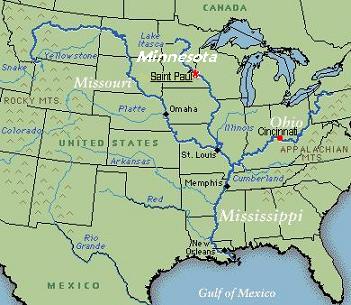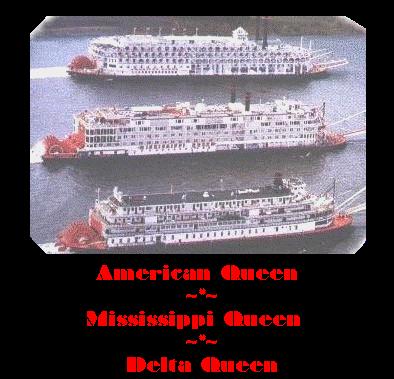

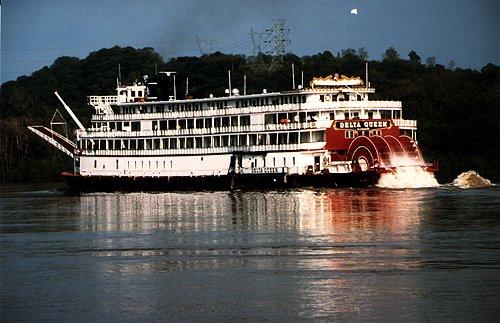
On the advice of a wise old roustabout, he chose the H.K. Bedford and thus created the Greene Line Steamers, entering it into service on the upper Ohio and Kanawha rivers. His young bride, Mary Becker Greene, soon began standing watch in the pilot house with him, and rapidly learned the river. Capt. Mary became one of the first licensed women pilots. The Greene Line expanded as more vessels were added to the fleet, and "home" for the fledgling Greene family was almost always aboard one of their boats.
 Capt.
Gordon's savvy as a businessman allowed the Greene Line
to thrive and survive many financial, political and
commercial obstacles that would spring up. Skillfully
merging with his rivals, building a reputation for customer
service and always delivering what it promised, the
Greene Line triumphed as more and more steamboats retired
from the river. Even as railways and trucking lines
carried an increasingly larger percentage of freight
once consigned to steamboats, the Greene Line kept its
share of cargo.
Capt.
Gordon's savvy as a businessman allowed the Greene Line
to thrive and survive many financial, political and
commercial obstacles that would spring up. Skillfully
merging with his rivals, building a reputation for customer
service and always delivering what it promised, the
Greene Line triumphed as more and more steamboats retired
from the river. Even as railways and trucking lines
carried an increasingly larger percentage of freight
once consigned to steamboats, the Greene Line kept its
share of cargo.
Realizing, though, that freight would not always sustain the line, Capt. Gordon expanded his operations to include passengers as well. At Capt. Mary's suggestion, he inaugurated a special charter down the Ohio River to the St. Louis World's fair. It was such a success that he scheduled several more during the fair's duration.
Capt. Gordon passed away in 1927 and was succeeded by his son, Capt. Chris, who shared his father's business acumen. Capt. Mary, now legendary as a river hostess, established the company's renowned standards for hospitality and passenger care. Capt. Chris passed away unexpectedly at a young age. His brother, Capt. Tom Greene, took over the reins and guided the Greene Line into the stormy days of World War II.
With a population on the home front starved for affordable wartime getaways that didn't involve travel on trains crowded with troops, overnight Steamboatin' vacations aboard the Greene Line vessels were wildly popular. The company steamed out of the war years strong and robust. Capt. Tom cast his eye around for a new luxury steamboat to augment the often filled-to-capacity Gordon C. Greene — and found it in California!
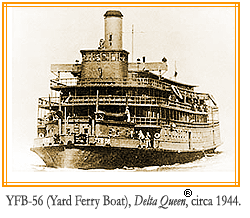 The
river steamers Delta Queen® and Delta King
were part of the Navy's large "mothball fleet"
near the Sacramento River. Both had served gallantly
during the war, functioning as troop carriers in San
Francisco Bay. The Delta Queen was required by the Navy as receiving ship for naval reservists. The first group arrived on October 16, 1940. The Delta King followed in November, 1940. This leases were planned for 6 months but in April, 1941, the Navy renewed the leases for another 6 months. In fall of 1941 both boats returned to Stockton but instead of returning them to regular passenger service the California Transportation Company sold the boats to the Isbrandsten Steamship Co. of New York. Both vessels should be towed to the East Coast via Panama Canal for use as excursion boats on the Hudson river. Pearl Harbor brought a turn in the fate of the boats. The Delta Queen and the Delta King rushed back into Navy service as emergency hospital transports. They were classified as Yard House Boats, the Delta King as YHB-6 and the Delta Queen as YHB-7, but retained their names. On July 5, 1944, reclassified the boats as Yard Ferry Boats, the Delta King as YFB-55 and the Delta Queen as YFB-56. During the founding conference of the United Nations from April 25 to June 26, 1945, the Delta Queen took delegates of the 51 gathered nations on sightseeing trips around San Francisco Bay. In 1946 the boats went into lay-up at the Reserve Fleet on Suisan Bay, called the "mothball fleet". The Delta King was off the Navy records on April 17, 1946, the Delta Queen on August 28.
The Delta Queen even served as
an elegant hostess for delegates to the United Nations
Founding Conference, and at one point, was a floating
gun installation, covering famed Alcatraz Penitentiary
during a prisoner uprising.
The
river steamers Delta Queen® and Delta King
were part of the Navy's large "mothball fleet"
near the Sacramento River. Both had served gallantly
during the war, functioning as troop carriers in San
Francisco Bay. The Delta Queen was required by the Navy as receiving ship for naval reservists. The first group arrived on October 16, 1940. The Delta King followed in November, 1940. This leases were planned for 6 months but in April, 1941, the Navy renewed the leases for another 6 months. In fall of 1941 both boats returned to Stockton but instead of returning them to regular passenger service the California Transportation Company sold the boats to the Isbrandsten Steamship Co. of New York. Both vessels should be towed to the East Coast via Panama Canal for use as excursion boats on the Hudson river. Pearl Harbor brought a turn in the fate of the boats. The Delta Queen and the Delta King rushed back into Navy service as emergency hospital transports. They were classified as Yard House Boats, the Delta King as YHB-6 and the Delta Queen as YHB-7, but retained their names. On July 5, 1944, reclassified the boats as Yard Ferry Boats, the Delta King as YFB-55 and the Delta Queen as YFB-56. During the founding conference of the United Nations from April 25 to June 26, 1945, the Delta Queen took delegates of the 51 gathered nations on sightseeing trips around San Francisco Bay. In 1946 the boats went into lay-up at the Reserve Fleet on Suisan Bay, called the "mothball fleet". The Delta King was off the Navy records on April 17, 1946, the Delta Queen on August 28.
The Delta Queen even served as
an elegant hostess for delegates to the United Nations
Founding Conference, and at one point, was a floating
gun installation, covering famed Alcatraz Penitentiary
during a prisoner uprising.
For a bid of slightly more than $47,000, Capt. Tom acquired the Delta Queen at government auction. (Interestingly, he was shortly thereafter offered the Delta King by the winner of its bid, who had been unaware he was buying a river paddlewheeler instead of an ocean-going freighter he was hoping for!) Considering it had cost nearly $1 million to build and outfit each of the sister boats, the Greene Line Steamers had a real bargain.
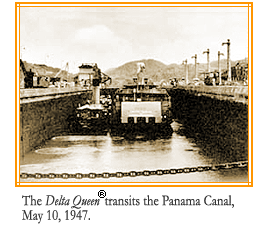 But
the Delta Queen was thousands of miles away from
the Mississippi River system. Under the supervision
of Capt. Fred Way, long a friend of the Greene family,
the Delta Queen was boarded up like a giant piano
box and was towed down the California coast, through
the Panama Canal, across the Gulf of Mexico and up the
Mississippi. Under its own power, it steamed proudly
upriver to Cincinnati and then to Pittsburgh, where
it underwent a thorough refurbishment.
But
the Delta Queen was thousands of miles away from
the Mississippi River system. Under the supervision
of Capt. Fred Way, long a friend of the Greene family,
the Delta Queen was boarded up like a giant piano
box and was towed down the California coast, through
the Panama Canal, across the Gulf of Mexico and up the
Mississippi. Under its own power, it steamed proudly
upriver to Cincinnati and then to Pittsburgh, where
it underwent a thorough refurbishment.
In 1948, the Delta Queen joined the Greene Line's fleet and took her place on the Mississippi system. Capt. Mary Greene, affectionately known to riverfolk as "Ma" Greene, still active on the river, moved into a specially outfitted suite on the Cabin Deck. She passed away several months later, having served 55 years on the river. Shortly after that, Capt. Tom died of an unexpected heart attack in 1950. His wife, Letha Greene, took over the company.
 An
economic downturn in the late '50s threatened the company
and Mrs. Greene sold all the vessels in the Greene Line's
fleet, except for the Delta Queen. Soon it became
apparent that she would have to shut down operations
entirely. But Steamboatin's a resilient American institution,
and a California businessman, Richard Simonton, enamored
with his vacations on the Delta Queen, stepped
in and rescued the company.
An
economic downturn in the late '50s threatened the company
and Mrs. Greene sold all the vessels in the Greene Line's
fleet, except for the Delta Queen. Soon it became
apparent that she would have to shut down operations
entirely. But Steamboatin's a resilient American institution,
and a California businessman, Richard Simonton, enamored
with his vacations on the Delta Queen, stepped
in and rescued the company.
He hired a brilliant young publicist named Betty Blake to help revitalize national interest in paddlewheel vacations on America's heartland rivers. She was so successful that by the mid-1960s, the Greene Line had paid off its entire debt, including the mortgage on the Delta Queen. But just as things were looking particularly rosy, Congress passed an American version of the international Safety of Life at Sea (SOLAS) convention. The days of substantially wooden passenger vessels were numbered. And the Delta Queen, with its rich woodwork, was among them.
Betty Blake organized a nationwide "Save the Queen" campaign. Petitions flooded the halls of Congress and ultimately, she and Steamboatin's many supporters triumphed. The Delta Queen continues to operate under a special congressional exception to SOLAS legislation to this day.
But to assure Steamboatin's continuity, the company began plans for an all-steel steamboat. Acquired by Overseas National Airways in 1969 and renamed the Delta Queen Steamboat Company in 1974, the steamboat line began construction on the largest steamboat the world had ever seen. The magnificent Mississippi Queen® featured a sleek white exterior, designed by James Gardner, designer of the Queen Elizabeth II. She was launched during the American Bicentennial in 1976 and proudly took her place alongside her venerable sister.
In the 1980s, the company was purchased by millionaire Sam Zell of Chicago. Its headquarters were moved from Cincinnati to a vintage, turn-of-the-century bulk cargo warehouse on the New Orleans riverfront, where the first-ever steamboat passenger terminal was constructed. Here, in 1990, the company's centennial was celebrated. In the early '90s, The Delta Queen Steamboat Company acquired the troubled American Hawaii Cruises line and its grand, historic ocean liners, the SS Independence and the SS Constitution. A Chicago-based parent company, American Classic Voyages, was formed to administer services shared by both cruise lines.
Steamboatin' proved one of America's most popular modes of leisure travel. Boasting an occupancy rate and repeat passenger percentages that were the envy of the cruise industry, it became evident that another steamboat was needed for the fleet. The grand American Queen® was launched in 1995 to meet the demand for folks seeking the all-American Steamboatin' experience.
In 1999, the Delta Queen Steamboat Company acquired an abandoned, incomplete vessel originally started as a Louisiana casino boat. Redesigned, it, like its older sister, was towed through the Panama Canal, this time in the opposite direction. In the summer of 2000, the adventurous Columbia Queen began service in the Pacific Northwest on the Columbia, Snake and Willamette rivers.
An unusually ambitious building program by American Classic Voyages in the late 1990s, made possible in part by the success of Steamboatin', caused financial strains on the company, which, when coupled with the terrorist attacks of September 11, 2001, threatened the continuation of Steamboatin' on America's rivers.
But once again, the fans of Steamboatin' flocked to preserve its legacy. Under new ownership of Delaware North Company, the legendary Delta Queen, the magnificent Mississippi Queen and the grand American Queen continue their service on the river. Back in charge of the company are Steamboaters who know, love and understand its significance and respect its long, distinguished legacy. "Blue water is out, brown water is in!" is our motto.
Yes, Steamboatin' endures, just as it has through floods, wars, political opposition and financial challenges. Because of river enthusiasts' affection for this cherished institution, Steamboatin' will always be a fixture on America's heartland rivers. And today's Steamboaters will proudly keep those big, red paddlewheels churnin', their wake beating out the rhythm of an American way of life that is kept alive only by the elegant paddlewheelers of the Delta Queen Steamboat Company.
